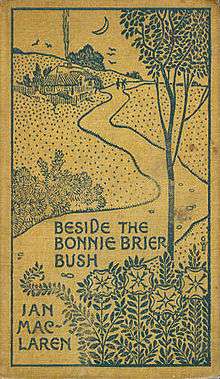Kailyard school

The Kailyard school of Scottish fiction (1880-1914) was developed in the last decades of the 19th century as a reaction against what was seen as increasingly coarse writing representing Scottish life complete with all its blemishes. It has been considered to be an overly sentimental representation of rural life,[1] cleansed of real problems and issues that affected the people, but proved for a time extremely popular.[2] Its name derives ultimately from the Scots "kailyaird" or "kailyard", which means a small cabbage patch (see kale) or kitchen garden, usually adjacent to a cottage;[3] but more immediately from Ian Maclaren's 1894 book Beside the Bonnie Brier Bush whose title alludes to the Jacobite song "There grows a bonnie brier bush in our Kailyard".[4]
Writers of the Kailyard school included J. M. Barrie, Ian Maclaren, J. J. Bell, George MacDonald, Gabriel Setoun, and S. R. Crockett.
Barrie's Auld Licht Idylls (1888), A Window in Thrums (1889), and The Little Minister (1891); and Crockett's The Stickit Minister (1893) are among the more lasting products of the school.[5]
Opposition
George Douglas Brown aimed his 1901 novel The House with the Green Shutters explicitly against what he called "the sentimental slop"[6] of the Kailyard school.
Much of Hugh MacDiarmid's work, and the Scottish Renaissance associated with him, was a reaction against Kailyardism.[7] [8]
Literary references
John Ashbery references the school in his book of poems, April Galleons, his protagonist lamenting mildly that "nobody I know ever talks about the Kailyard School, at least not at the dinner parties I go to".[9]
See also
References
- ↑ D. Daiches ed., The Penguin Companion to Literature: 1 (1971) p. 288
- ↑ I. Ousby ed., The Cambridge Guide to Literature in English (1995) p. 503
- ↑ Cuddon, J. A. (1977) A Dictionary of Literary Terms. London: André Deutsch; p. 343
- ↑ Macdonald, A. M., ed. (1972) Chambers Twentieth Century Dictionary. Edinburgh: Chambers; p. 716
- ↑ D. Daiches ed., The Penguin Companion to Literature: 1 (1971) p. 288 and p. 126
- ↑ D. Daiches ed., The Penguin Companion to Literature: 1 (1971) p. 157
- ↑ Andrew Nash, Kailyard and Scottish Literature (2007) p. 15
- ↑ Campbell, Ian (1981), Kailyard: A New Assessment, The Ramsay Head Press, Edinburgh
- ↑ John Ashbery, Notes from the Air (2007) p. 27
Further reading
G. Blake, Barrie and the Kailyard School (1951)
External links
- Kailyard School (1886-1896), The Literary Encyclopedia
- Scots Word of the Season: Kailyard, Maggie Scott, Lecturer in English Language, University of Salford, published in The Bottle Imp ezine by the Association for Scottish Literary Studies.